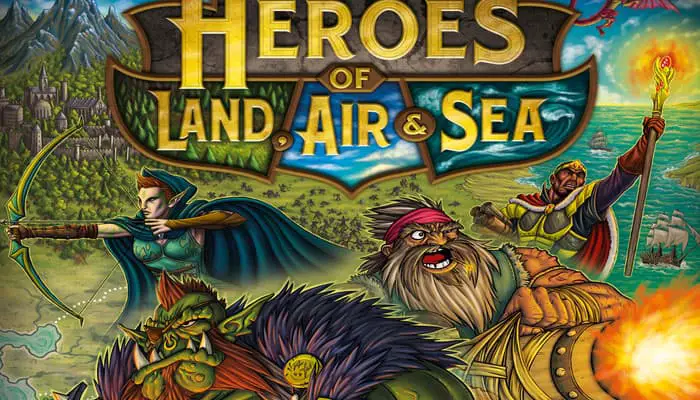
Heroes of Land, Air & Sea is a 4X-style board game that tells the epic tale of Aughmoore's many conflicts: Orcs vs. Humans, Dwarves vs. Elves, battling kingdoms, and the heroic individuals who turn the tides of war.
Players control one of these four Factions, competing to expand their small kingdom of a single Warrior and two Serfs into new territory. From there, players must explore the territory around them, expand their work force, fortify their army, and build up their Capital City - all through careful action selection, exploitation, war, and Resource management.
As players reach milestones through building, recruiting, or war, they gain access to many advantages and Victory Points. Achieving one of four "X-Objectives" will end the game: eXplore, eXpand, eXploit, or eXterminate.
Finding this balance in exploration, kingdom growth, territory exploitation, and war is crucial. After one of the X-Objectives have been met, the game is over and players total their Victory Points, crowning one of them as the most supreme Faction of Aughmoore!
Components

- 4 Capital City Boards
- 80 Miniatures
- 12 Hero Cards
- 32 Constructs
- 12 Faction Tokens
- 1 Game Board
- 28 Tactic Cards
- 60 Spell Cards
- 8 Solo Enemy Cards
- 94 Exploration Tokens
- 15 Resource Tokens
- 1 First Player Token
- 1 Quick Reference Sheet
- Instructions
Object of the Game
Every round, players are exploring, building their Capital City, casting Spells, and Battling to gain Victory Points ( ).
).
After one player achieves any one of the 4 "X-Objectives", then players finish the current round as normal and play one additional full round which will be the final round. These "X-Objectives" are:
- eXplore - All Land Exploration Tokens in the game have been revealed.
- eXpand - All of a player's Serfs and Warriors are in play.
- eXploit - All 3 of a player's Towers are in play.
- eXterminate - A player has destroyed another player's Capital City.
Once the end of the game has been triggered, it cannot be undone, even if the end game conditions are no longer met. After the final round ends, the game is over.
Players total their Victory Points, from Buildings, Towers, certain Units, Scribed Spells, occupied Regions, and any other end game bonuses. The player with the most Victory Points is crowned the supreme Faction of Aughmoore.
Setup

-
Place the Game Board in the center of the table. For a 1-4 player game, use the side of the board with the "1-4" in the upper-left corner. The reverse side of the board with the "5-6" requires the Order & Chaos Expansion.
-
Each player selects a Faction and collects its Faction Components:
-
Place the Capital City (C.C). Board in each player's area.
-
Collect the 20 Units and 8 Constructs (3 C.C. Levels, 3 Towers, and 2 Vessels):
- Place the Units and Vessels below the C.C. Board under, or near, their corresponding slots. This is considered a player's "supply".
- Place the Towers and C.C. Levels to the left of the board near their corresponding slots.
- From the supply, place 2 Serfs and 1 Warrior into the Courtyard at the top of the C.C. Board.
-
Place the 3 Hero Cards near the right side of the C.C. Board. Leave enough room to place future Spell Cards in the 3 slots designated for Scribed Spells.
-
Place the 2 Action Tokens into the Courtyard at the top of the C.C. Board.
-
Place 3 Resource Tokens (1 Ore, 1 Mana, and 1 Food) onto the "2" space of the Resource Track (note the Watermark images of the Resource types).
-
Collect a complete set of 7 Tactic Cards (each listed "X of 7").
-
Place the Score Token off the board next to (but not on) the "1" space on the Score Track, designating a starting score of "zero".
-
-
Shuffle the Spell Cards and place the deck face-down near the top of the Game Board. Also designate an area for a face-down Discard Pile nearby. Then, deal 1 Spell Card to each player to be placed in their "hand", also referred to as a player's "Spell Library". Always keep cards in your Spell Library secret from other players.
-
Take 3 Resource Tokens (1 Ore, 1 Mana, 1 Food), which have not yet been used, and while cupped in a player's hand, drop tokens out one at a time. The first token to fall, is placed on the "4" space of the Tax Track (bottom left of the Game Board), the second on the "3", and the final on the "2". This determines the starting Tax Track values.
-
Give the youngest player the First Player Token, or choose who starts the game using any other method. You can also download our Heroes of Land, Air & Sea mobile app which provides a randomizer for selecting the starting player.
-
Players next decide on which Continents to place their Capital Cities. Starting with the player to the right of the first player (with the First Player Token) and going counterclockwise, players place their Lv. 1 C.C. Construct in a Capital City Region on a Continent adjacent to another player's Continent, except for the first player to choose, who may choose any Continent to start on.
Note: there is only 1 C.C. Region per Continent and therefore each player will have their own Continent to start. Once all players have chosen where their C.C. will go, the game is ready to begin.
-
Shuffle the Exploration Tokens face-down, and then place them face-down onto Regions on the Map:
Land Regions, except for where a player's Capital City is present, receive 1 (brown) Land Exploration Token, except for Swamp Regions, which receive 2 Land Exploration Tokens.
Sea Regions receives 1 (blue) Sea Exploration Token, except for the center Sea Region (with the image of the Octopus, and if playing with the expansion, the second center Sea Region with the image of a Sea Serpent), which receives 2 Sea Exploration Tokens.
Any unused Exploration Tokens are returned to the box without being revealed.
Note: In 1-2 player games, 1 of the 4 continents, chosen by the player(s), will not be used and is not accessible by players. No Exploration Tokens should be placed on this continent. Regardless of player count, all Sea Regions are accessible and should receive Exploration Tokens.
- In 1-2 player games, use 3 Continents. In 3-4 player games, use all 4 Continents.
- In 5-6 player games (using the Order & Chaos Expansion), use all 6 Continents.
Capital City Board Overview
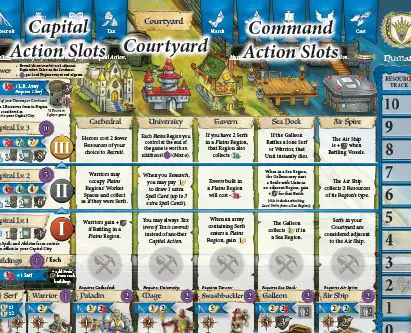
Each Capital City Board represents the Capital City of a Faction. The board has 2 sides: a Multiplayer side and a Solo Enemy side. An example of the Multiplayer side is shown here. It includes:
-

Towers: lists the game information for Towers to be built and used.
-

Capital City Levels: represents the current level of a Faction's C.C. (always starting at Lv. 1). The necessary game information needed for each future level to be built is included on the C.C. Board.
-

Buildings and Abilities: lists the Factions Buildings that can be built. Buildings grant unique abilities and, as the level of the C.C. increases, more abilities become available.
-

Units and Vessels: lists the Faction's Units and Vessels (Vessels are also considered Units). These are available to be recruited.
-

Resource Track: The numbered spaces on the track represent the amount of each Resource a player has, marked by Resource Tokens. No one Resource type can ever exceed "10".
At the top of the C.C. Board is the Courtyard and an Action Bar that includes 9 Action Slots split into 2 types of actions: Capital Actions and Command Actions.
These represent the game actions that a player may perform using Action Tokens and Serfs (from the Courtyard).
Game Play
Each round has 3 Phases, performed in order:
-

Action Selection
Starting with the first player (with the First Player Token), and then going clockwise in turn, each player selects and performs one action.
The player places one of their Action Tokens onto an open Action Slot at the top of their Capital City Board.
Once an action is selected, the player cannot perform that action again for the rest of the round unless granted by a Spell or ability.
This process of selecting an action will be done twice, so each player will use both of their Action Tokens.
-

Collection
Once all players have completed the Action Selection Phase, they simultaneously collect Resources based on Regions they controland also draw 1 Spell Card into to their Spell Library.
A player can only have 1 Spell Card in their Spell Library per level of their C.C.
-
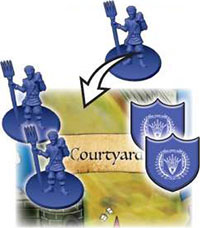
Round End
After the Collection Phase, all players remove Action Tokens and Serfs from the Action Bar, placing them back into their Courtyards.
Rotate 90° any Scribed Spells that have been cast.
The First Player Token then rotates clockwise to the next player, and the next round begins.
Phase 1 - Action Selection
On their turn, players place an Action Token on 1 unused action on the Action Bar. There are 2 categories of Actions:
Capital Actions - Actions that can be "Followed" by other players using Serfs.

Command Actions - Actions that, when selected, allow the player to "Muster", using a Serf to immediately perform a second Command Action.

A. Capital Actions
The 4 Action Slots on the left side of the Action Bar are as follows:

1. Recruit Units
Pay Resources to recruit 1 new Unit. The cost to recruit is listed in the banner next to the Unit at the bottom of the C.C. Board
After paying the cost, the Unit is placed in the Courtyard. Only 1 Unit can be recruited with this Action each time it is taken.

The exception is with Serfs: 3 Food may be spent to recruit 2 Serfs. Each Warrior in play is worth  at the end of the game.
at the end of the game.
Recruiting Heroes and Vessels
Players can recruit Heroes and Vessels if certain Buildings are built in the Capital City.
Heroes' Abilities
Each Hero comes with 3 unique abilities, as noted on their Hero Card. Each ability is aligned with  ,
,  , and
, and  , which are unlocked by upgrading your current Capital City Level.
, which are unlocked by upgrading your current Capital City Level.
Note: In the event that abilities conflict with the game's rules, the abilities always takes precedence.
Placing Vessels on the Map:
When Recruited or Built (see below), Vessels are placed on the Map, not into the Courtyard:

-
Sea Vessels must start docked on the Shore of your Capital City Region, which is the border between the Land Region and its adjacent Sea Region.
Note: docked Sea Vessels are considered to be in the Land Region NOT the Sea Region.
-
Air Vessels start fully in the Capital City Region.
Boarding Vessels:

Units may be exchanged freely between the Vessel and the Land Region it occupies or whose Shore it is docked with (in the case of Sea Vessels).
That includes boarding from the Courtyard into the Vessel if it is in the Capital City Region.
Each Vessel has a maximum capacity of 2 Units, as listed on the C.C. Board. Vessels cannot be boarded while moving.

2. Build
Pay Resources to:
- Build a Vessel in the C.C. Region (required Building needed). Building a Vessel is the same as Recruiting a Vessel, except a Build Action is used (see the rules for Vessels above).
- Build a new Building on the C.C. Board
- Upgrade the Capital City to the Next Level
- Build a Tower
Build a new building

Pay 3 Ore and then move a Serf from the Courtyard, placing it onto the Worker Space underneath the Building.
This indicates that it is built, and now the player has access to its abilities listed above as well as the Hero or Vessel, pictured below, now being available to recruit (or build in the case of Vessels) during a future action.
Each Building unlocks new abilities as the Capital upgrades. The Serf used to build the Building MUST stay on this Worker Space for the remainder of the game and cannot be used in any other action, nor can it be destroyed or sacrificed.
Each completed Building is worth  at the end of the game and each Serf occupying a building Worker Space still offers its
at the end of the game and each Serf occupying a building Worker Space still offers its  when defending a Battle in your Capital City Region.
when defending a Battle in your Capital City Region.
Upgrade the capital city to the next level

Pay the Resources listed in the next level's banner on the C.C. Board. To signify the new level, stack the next smaller C.C. Construct from the supply on top of the existing C.C. Construct.
Upgraded Capitals unlock new abilities with Buildings and Heroes as listed on the C.C. Board and Hero Cards.
It also increases the C.C.'s Strength ( ), the numbers of Towers and Spell Cards a player can have and Scribe, and the
), the numbers of Towers and Spell Cards a player can have and Scribe, and the  the Capital City is worth at endgame
the Capital City is worth at endgame
Build a Tower

A player may build a Tower in a Land Region where they have a Serf present.
The cost of building a tower is 1 Ore for each land region away from the Capital City the target Region is. This distance should be the minimum number of Land Regions is would take a Unit to March there.
When a Tower is built, reveal, but do not resolved all the face-down Land Exploration Tokens in the Land Regions adjacent to the Tower that are on the same Continent as the Tower.
The tokens are resolved when another Unit enters those Regions.
Unlike when building a Building, the Serf is not required to stay in that Region; they are treated as a normal Unit.

3. Research or Scribe Spells
Researching allows players to build an arsenal of powerful Mana Spells. Select the Research Action to choose from 2 separate options:
-

Conjure Spells - draw 3 Spell Cards from the Spell Deck. Then choose which cards to keep in the player's Spell Library (a hand of Spell Cards) and which to discard.
Note that there is a Spell Library Hand Limit based on the player's C.C. Level. When finished Researching, discard Spells (from those you drew and/or from those already in your Spell Library) until the number of Spells in your Spell Library is equal to your current Hand Limit.
-
Scribe a Spell - take 1 Spell Card in your Spell Library and permanently place it face-up in a Scribed Spell Slot on the right side of the C.C. Board. Scribed Spells cannot be discarded at any time.
Players may have only as many scribed Spells as the level of their Capital City. A Lv. 2 C.C. allows a player to have 2 total Scribed Spells. Players may only Scribe Spell Cards labeled "CAST".
They may never Scribe Spell Cards labeled "COMBAT1 or "INTERRUPT". Each Scribed Spell is worth
 at the end of the game.
at the end of the game.
The cards you choose are kept in your Spell Library or Scribed Spell Slots to be Cast in later actions. Scribed Spell Cards are NOT discarded when they are Cast, nor can a player willingly discard one. When the Spell Deck runs out, shuffle the discard pile and form a new deck.
Spell Card Types
There are 3 types of Spell Cards which are labeled on the card:
-
Cast
Require you to select the Command Action: Cast to use. These Spell Cards are the only Spells that may be Scribed.
-
Combat
May only be Cast during a Battle. Cannot be Scribed. Combat spells may not be copied with a Copy Spell card by a player not involved in the current Battle.
-
Interrupt
May be used immediately after an enemy player has Cast a Spell. Cannot be Scribed.
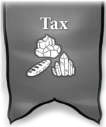
4. Tax for Resources

Select the Tax Action to gain one type of Resource, the amount of which is labeled in the Tax Track located in the bottom left of the Game Board.
The player chooses one of the 3 Resources and immediately gains the amount listed on the slot that the Resource's Token is in.
The slots are labeled "4", "3", and "2".
After Taxing is complete (including Followed Actions), the Resource Tokens advance; the token in "slot 2" moves to "3", the "3" to the "4", and the "4" then cycles back to the beginning "2" slot.
Following a Capital Action
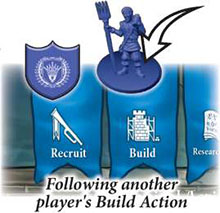
When a player selects a Capital Action, other players may choose to "Follow" the same action.
To Follow, the player must have that Action Slot open and have an available Serf in their Courtyard.
Move a Serf from the Courtyard and place it in that Action Slot. That player may perform the selected action, even though it is not their turn. Only Capital Actions, not Command Actions, may be followed.
Serfs in the Action Bar cannot be used for any other Actions this round, cannot be targeted or sacrificed in Battle and cannot be the target of any Spells, but they do offer their Strength value if the Capital C fflSHSIST|acked.
Serfs must remain in their Action Slots until the end of the round. This fills that Action Slot for the remainder of the round and that action may not be taken again, neither by following with another Serf nor by taking a traditional action with a Faction Token.
Note: To keep the game moving smoothly, it is important for any players that are following to do so simultaneously. In the rare event that a conflict arises, resolve the actions in player order, starting with the active player.
B. Command Actions
The 5 Action Slots on the right side of the C.C. Board are as follows:

1. March a Unit or an Army
Move 1 to 5 Units from a single Land Region, called an "army", into another Land Region. An army can consist of any number or combination of Units, from a single Serf to multiple Serfs, Warriors, and Heroes.
Regions have a limit of 5 Units per Faction after Marching, but not when an army is moving through a Region.
The number of Regions a Unit may move in a March is called its Speed ( ) and is listed next to its picture on the C.C. Board. The army can only move as many Regions as allowed by the lowest-Speed Unit.
) and is listed next to its picture on the C.C. Board. The army can only move as many Regions as allowed by the lowest-Speed Unit.
For example, an army containing 2 Warriors with  and a Paladin with
and a Paladin with  may only move 1 Region because of the Paladins low Speed.
may only move 1 Region because of the Paladins low Speed.

Note: There are 2 March Action Slots, so this Action may be performed twice. It can even be performed twice during the same round by Mustering, even by the same army.
Marching into Battle
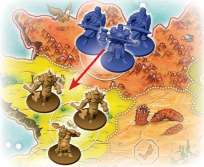
Armies must stop a March when they enter a Region with an opponent's Units, Vessels, Tower or Capital City.
This ends a March Action, and it immediately results in a Battle between the two players.
Towers are Adjacent to the Capital
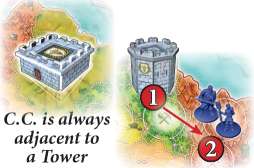
Each player's C.C. Region, and their Units in the Courtyard, are always considered to be adjacent to all Regions with the player's Towers.
Note: Towers are not adjacent to other Towers.
Exploring Land Regions
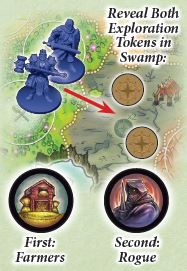
If the army ENDS its March in a Land Region that has a face-down Exploration Token, it is immediately revealed and then resolved (see the Reference Sheet for outcomes).
In a Swamp Region, 2 Exploration Tokens are revealed and resolved one at a time.
Do not reveal the second token until the first is resolving. Armies may March through "unexplored" Regions without revealing their Exploration Tokens.
Ending a March in a Desert

Units cannot pass through a Desert Region in a single March Action, even if they have sufficient Speed to do so. They must end their March upon entering and may move out with a subsequent March Action.
Ferry Routes and Graticules:

Continents are connected by Ferry Routes, which link Land Regions together and separate Sea Regions. Two Regions connected by a Ferry Route are considered adjacent, and this is the only way for Land Units to travel across Sea Regions without a Vessel.
Graticules are the letters or numbers marked on the outside of the map that have matching pairs directly opposite from each other.
Attached to Ferry Routes, these are considered connected and "wrap-around'' to the opposite side of the map.
For example, this army uses 0 to March north using the "A" Ferry Route into the southern continent's Region on the opposite side of the map.

2. Sail a Sea Vessel
Using its Speed, the Sea Vessel may only sail into Shore and Sea Regions. Shore Regions are any Land Regions that border the Sea:
Docked Sea Vessels must use
 to first sail from Shore to Sea. A docked Sea Vessel may move into any Sea Region adjacent to that shore. Sea Vessels cannot move from one shore to another without first moving into a Sea Region.
to first sail from Shore to Sea. A docked Sea Vessel may move into any Sea Region adjacent to that shore. Sea Vessels cannot move from one shore to another without first moving into a Sea Region.Use
 to sail to adjacent Sea Regions separated by Ferry Routes.
to sail to adjacent Sea Regions separated by Ferry Routes.Use
 to sail from a Sea Region to dock onto a Shore.
to sail from a Sea Region to dock onto a Shore.Sea Regions on directly opposite sides of the board, between 2 Ferry Routes with at least 1 matching Graticule, are considered adjacent.
When a vessel is "docked" on a Shore, the Vessel is placed halfway between both the Land and Sea Region. Land Units on the Shore may freely board and exit the docked Vessel, however, a Sea Vessel may not march with an army. Sea Vessels do not require Units aboard to sail.
Exploring Seagions:
If the Sail ENDS in a Sea Region that has a face-down Exploration Token, it is immediately revealed and then resolved (see the Reference Sheet for outcomes).
In the Central Sea Region, 2 Exploration Tokens are revealed and resolved one at a time. Do not reveal the second token until the first is resolving. Sea Vessels may Sail through "unexplored" Sea Regions without revealing their Exploration Tokens.
Ending a Sail in the Central Sea Regions

Like armies Marching through a Desert Region, Sea Vessels cannot Sail through the Central Sea Region in a single Sail Action.
They must end their Sail upon entering and may move out with a subsequent Sail Action.
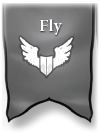
3. Fly an Air Vessel
Using its Speed, an Air Vessel:
May Fly through adjacent Land Regions, as if it were marching (including between Towers and the Capital City).
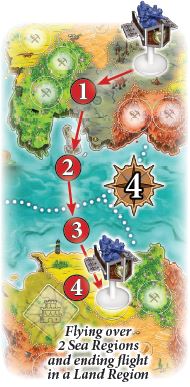 May not use Ferry Routes.
May not use Ferry Routes.May Fly through Sea Regions, but may not end flight in a Sea Region.
May Fly into a Sea Region to Battle a Sea Vessel, but if it survives it has only
 to return to a friendly or unoccupied Land Region. If it cannot do this, the Air Vessel is destroyed.
to return to a friendly or unoccupied Land Region. If it cannot do this, the Air Vessel is destroyed.May pass through unexplored Land Regions, and also may end its flight to explore Regions with Land Exploration Tokens. However, if there are no Units aboard the vessel and the token's outcome requires the player to lose a "Unit", the player must lose the Air Vessel.
May not explore Sea Regions.
MUST stop in a Region with enemy Units or Structures to Battle.
May Fly through a Desert Region WITHOUT stopping.
Like the Sea Vessel, the Air Vessel may carry passenger Units which can freely board and exit the vessel if sharing the same Region but not in the middle of a Fly Action. Air Vessels do not require Units aboard it to fly.
Note: Air Vessels may not move using a March Action.
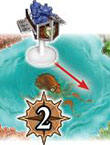
Flying Through the Central Sea
The Central Sea Region counts as 2 Regions when flying, so it requires  to fly an Air Vessel through it.
to fly an Air Vessel through it.
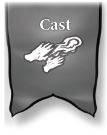
4. Cast a Spell
Reveal 1 Spell Card from your Spell Library (hand of Spell Cards) OR select 1 Scribed Spell. Then pay the cost of Mana ( ) listed in the upper left corner, and perform the action listed on the card.
) listed in the upper left corner, and perform the action listed on the card.
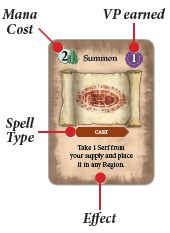
Casting immediately gains the Victory Points ( ) listed in the upper right of the card for the player that cast the Spell (advance Score Token). A card Cast from your Spell Library is discarded.
) listed in the upper right of the card for the player that cast the Spell (advance Score Token). A card Cast from your Spell Library is discarded.
Only Spells labeled "CAST" may be used in a Cast Action. "COMBAT" Spells may only be used in Battles, and "INTERRUPT" Spells can be used any time an enemy casts a Spell. Unless stated otherwise, Capital City Regions and Units inside cannot be affected by enemy Spells. However, while in a Battle within a Capital City Region, Combat Spells may be used.
Casting Scribed Spells
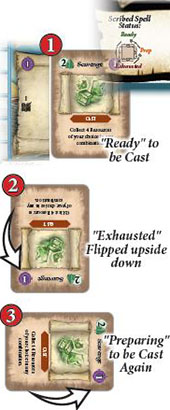
A Spell in a Scribed Spell Slot may be used instead of one from the Library, and only when it is pointing upward in the "Ready" position 1.
After casting, rotate the Scribed Spell Card upside down (top pointing down) to designate it as "Exhausted" 2.
During the Round End Phase, all Scribed Spell Cards that are not "Ready" rotate once 90° counter-clockwise.
"Preparing" Spell Cards 3 will rotate so that the top is facing up (these Spells are now "Ready" to be Cast again during the following round).
Then "Exhausted" Spell Cards will rotate so that the top is facing to the right. These Spells are now "Preparing" and will be unavailable to Cast during the following round. They will rotate again to "Ready" during the next Round End Phase.
Mustering a Command Action
After a player selects a Command Action and resolves it, they may immediately "Muster" a second Command Action by placing 1 Serf from their Courtyard into an open Action Slot.
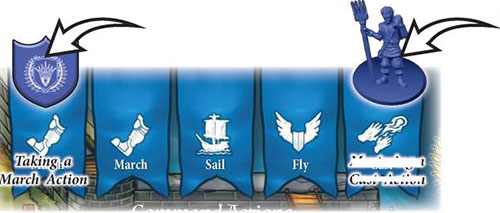
Only Command Actions may be Mustered. Fully resolve each action in the order they are taken. For example, you could March, then Muster and cast a Spell. Or even March twice (with the same or different armies) using a Muster to use both March Actions.
Battling
When an army or Vessel moves into a Region with enemy Units or Structures, its movement ends and a Battle occurs.
One players army will be victorious and allowed to remain in the Region, but the other army must leave and possibly lose Units. The player who initiates the Battle, called the attacker, immediately gains  (advance the Score Token).
(advance the Score Token).
Note: a player who uses an ability to move enemy Units into a Region with their own Units is still initiating the Battle and considered the attacker.
Total Each Army's Strength
Both players total the Strength ( ) of all the Units, Vessels, and Structures in the Battle:
) of all the Units, Vessels, and Structures in the Battle:
-
The "Natural Strength" is the
 value as listed beside the Unit's picture on the Capital City Board, or its card, before bonuses are considered. For example, a Paladin has a Natural Strength of
value as listed beside the Unit's picture on the Capital City Board, or its card, before bonuses are considered. For example, a Paladin has a Natural Strength of  .
. -
Next add in all ability bonuses of Heroes, Vessels, and Structures that increase Strength. Defenders apply their abilities first, then the attacker.
-
Cast 1 Combat Spell to add
 to an army, decrease
to an army, decrease  from an enemy army, or destroy enemy Units. The defending player always casts a Combat Spell first.
from an enemy army, or destroy enemy Units. The defending player always casts a Combat Spell first.Once defender does so or announces that they are not casting, the attacking player may then cast a Combat Spell. The defender may not cast a Combat Spell after the attacker has, however Interrupt Spells may still be cast.
For example, the attacking player casts Rage which says "Before Tactic Cards are chosen, gain
 ".
".
Select a Tactic Card to Play
After totaling the Strength of their armies, both players gather their hand of 7 Tactic Cards, and each secretly selects one card to play which adds a bonus to their army's Strength.
In the event that one or both players have no Units or Structures remaining in the Region due to spells or abilities, the Battle ends and no Tactic Cards are played.
The amount of  added is listed in the upper left of the card, as well as any bonus
added is listed in the upper left of the card, as well as any bonus  or effects listed below if against a specific card chosen by the enemy.
or effects listed below if against a specific card chosen by the enemy.
Note: The Conscripts Tactic Card may change the composition of the Armies, which may change the ability bonuses of the Heroes, Vessels, and Structures. Win or lose, each player must pay the cost of the Tactic Card, and each player gains the  listed on the Tactic Card they played.
listed on the Tactic Card they played.
If both players played Conscripts, the defender resolves it first, then the attacker.
When players select a Tactic Card, they must factor in these two rules:
The player MUST be able to afford the cost of the Tactic Card, as noted on the upper left of the card, and MUST Spend the appropriate Resources AND/OR Sacrifice Units (see below).
Some Tactic Cards may only be played by an attacking or defending player, and some may not be played if there are only Serfs in the army and no Structures.
Note: If a player cannot pay the cost and meet the requirements then their card is ignored and considered a  player may NOT choose to not pay the cost of their selected Tactic Card and ignore it if they can afford to pay the cost, in Resources and/ or in Units.
player may NOT choose to not pay the cost of their selected Tactic Card and ignore it if they can afford to pay the cost, in Resources and/ or in Units.
If a Tactic Card or other ability cancels your Tactic Card, you do not have to pay the resource cost, nor do you gain its VP (positive or negative).
Sacrificing Units in Battle
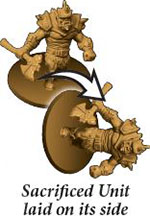
Players may choose to sacrifice one or more Units (not including Vessels') to help pay for the cost of a Tactic Card (even if they have enough resources to pay for the Tactic Card without sacrificing).
The Natural Strength of the Unit sacrificed can go toward paying the cost of the Tactic Card.
The Strength values of Sacrificed Units are still counted toward the army's total Strength. Lay Units on their sides to signify that they are being sacrificed.
After the Battle resolution begins but before Damage is assigned, Sacrificed Units are removed from play, considered destroyed in battle, and returned to their owner's supply.
Only Units (except for Vessels) may be sacrificed. Neither Vessels nor Structures may be sacrificed.
Resolving the Battle
The army with the highest  value wins, with ties going to the defender:
value wins, with ties going to the defender:
The winning army remains in the Region and loses no Units, except for Sacrificed Units (if any) to pay for their Tactic Card. The losing army:
takes "Damage" and must lose Units and/or Structures whose Natural Strength totals at least half of the the losing army's Natural Strength (rounded up). Natural Strength of the loser's army is calculated AFTER removing any Sacrificed Units.
Damage is deducted from each Unit, Vessel, or Tower's own Natural Strength, and the losing player may choose which Units are lost.
Any Tower MUST be lost first since it may not remain in the Region with enemy Units and may not be moved to your Capital City.Damage must be assigned completely to one Tower, Unit, or Vessel before the rest of the damage is assigned to remaining Units or Vessels.
If a Structure, Unit, or Vessel takes any damage at all, even 1, it is destroyed. Destroyed Units are returned to the supply.
Any remaining Units must be returned to that player's Capital City or a Region containing a Tower they control.
Battling with Towers
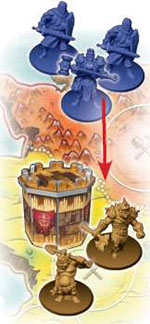
Armies may Battle in Regions with Towers, which have a Natural Strength of  (counts toward your army's Natural Strength for purposes of Battle and determining Damage).
(counts toward your army's Natural Strength for purposes of Battle and determining Damage).
Towers are also considered adjacent to the Capital City's Courtyard, so a defending player may use the Conscripts Tactic to move Units from their Courtyard into the Battle.
If the defending player loses the Battle, the Tower MUST take damage first before all other Units or Vessels in the army.
Towers are then "destroyed" and returned to the supply. A destroyed Tower may be built again on a future Build Action.
Battling with Vessels
Vessels Battle from either air or sea. They may Battle without passengers aboard, but if carrying passengers be sure to add both the  of the Vessel and any Units aboard together.
of the Vessel and any Units aboard together.
Sea Vessels Battle Land Units in the Land Region whose Shore it docks on.
Battling a Capital City
To achieve the "eXterminate Objective", players may Battle an enemy's Capital City. To total the Capital City's Natural Strength:
Add
 listed for the Capital City's current Level only.
listed for the Capital City's current Level only.Add
 from any Units in the Courtyard and Action Bar along with their bonuses.
from any Units in the Courtyard and Action Bar along with their bonuses.Add
 of any Vessels in or docked on the Shore of the Capital City Region.
of any Vessels in or docked on the Shore of the Capital City Region.Add
 of any Serfs in any completed Buildings' Worker Spaces.
of any Serfs in any completed Buildings' Worker Spaces.Towers are considered adjacent to the Capital City so any armies in Regions with your Towers may be moved into the Battle using the Conscripts Tactic Card.
Note: Your Capital City can hold any number of Units and is not subject to the normal limit of 5 Units per Faction.
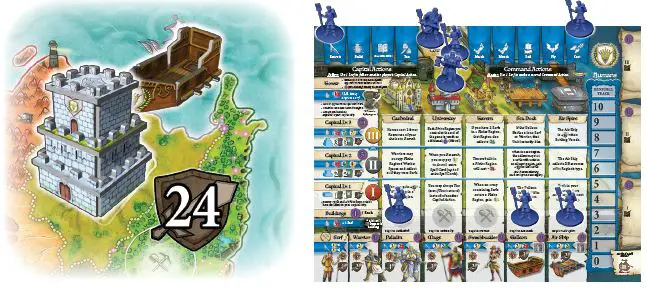
For example, this Capital City is Lv. 3, so it naturally has  . There are 3 Serfs, 1 Warrior, and a Paladin (has a bonus ability) in the Courtyard and Action Bar, so together with bonuses they have
. There are 3 Serfs, 1 Warrior, and a Paladin (has a bonus ability) in the Courtyard and Action Bar, so together with bonuses they have  . A Sea Vessel docked on the Shore Region has
. A Sea Vessel docked on the Shore Region has  .
.
The 3 Serfs on Buildings' Worker Spaces together have  . Therefore added togehter, the total Strength of the Capital City before Tactic Cards are chosen is
. Therefore added togehter, the total Strength of the Capital City before Tactic Cards are chosen is  .
.
If a player's Capital City is destroyed, that player is immediately eliminated from the game. They do not participate in end game scoring and their total score is 0.
Remove all their Units, Vessels, and Structures from the Game Board.

The player who destroys the Capital City gains  in addition to points from starting the Battle, their Tactic Card, and Combat Spell (if any).
in addition to points from starting the Battle, their Tactic Card, and Combat Spell (if any).
Note: Abilities and Spells performed by enemy players cannot affect the Capital City from OUTSIDE, but during a Battle INSIDE the Capital City Region, abilities can take effect.
For example, an enemy player cannot cast "Earthquake" and cause another player to lose Units from their Capital City. But, if they were in a Battle with the Capital City, they could cast "Fireball", causing a loss of Units there.
Spells and Abilities, even during a Battle in the Capital City, cannot remove Serfs from the Action Bar or Building Spaces, nor can those Units be Sacrificed to pay for Tactic Cards.
Phase 2 - Collection
After all players have performed two actions, completing the Action Selection Phase, then players simultaneously:
-
Collect Resources
Gain Resources from controlled Regions. A Region is controlled by the player having at least 1 Unit or Structure there. Certain "Resource Regions" yield a single type of Resource:

Each controlled Resource Region yields 1 Resource of its kind. In addition, Resource Regions also contain "Worker Spaces" where 1 Serf may be placed to collect 1 additional Resource from that Region. If a Tower is in a Resource Region, it collects 2 additional Resources.
For example, this player collects:
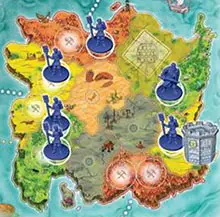
2 Ore (1 controlled Mountains, with 1 Working Serf)
4 Mana (2 controlled Forests, one with 2 Working Serfs and one with 1 Warrior)
6 Food (2 controlled Plains, one with 1 Working Serf and one with 1 Working Serf and a Tower)
-
Draw a Spell Card
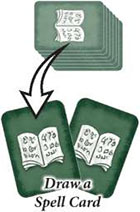
Each player draws 1 Spell Card from the Spell Deck and adds it to their Spell Library.
Then if any player has more Spell Cards than allowed by their Spell Library Hand Limit (equal to their Capital City Level), they choose a Spell Card to discard face-down.
Remember that Scribed Spells do not count against your Spell Library Hand Limit.
Phase 3 - Round End
After Collection, all players return Serfs and the Action Tokens in their Action Bar back to their Capital City's Courtyard. Rotate any Scribed Spells:
- "Preparing" (sideways) 90° counter-clockwise to "Ready".
- "Exhausted" (upside down) 90° counter-clockwise to "Preparing".
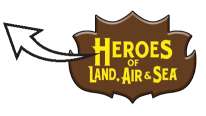
Then pass the First Player Marker to next the clockwise player, and then start the next round.
End of the Game
The end of the game is triggered if any of the four "X-Objectives" is achieved.
Once one is achieved during a game round, finish the current round and then play one additional full round, which will be the final (in a 1-2 player game, if a player triggers the end through eXterminate, the game immediately ends).
The end of the game cannot be "un-triggered", even if conditions for the X-Objective are no longer met. After the final round, players total up their final Victory Points. The X-Objectives are as follows:
- eXplore - All Land Exploration Tokens in the game have been revealed.
- eXpand - All of a player's Serfs and Warriors are in play.
- eXploit - All 3 of a player's Towers are in play.
- eXterminate - A player has destroyed another player's Capital City.
Final Scoring
Players total their final scores. In addition to their current scores from casting Spells, Battling, and certain Exploration Tokens, players now advance their Score Tokens:
 for each recruited Unit and Vessel in the game (not in the supply) as listed on the Capital City Board.
for each recruited Unit and Vessel in the game (not in the supply) as listed on the Capital City Board. for each completed Building.
for each completed Building.e for each built Tower (
 per Land Region away from the C.C)..
per Land Region away from the C.C).. for the final Capital Level as listed on the C.C. Board (no
for the final Capital Level as listed on the C.C. Board (no  if at Lv. 1).
if at Lv. 1). for each Scribed Spell.
for each Scribed Spell. for each Land and Sea Region you control at the end of the game (not including your Capital City or Shores). A Region is controlled if a Unit or Structure is present in that Region.
for each Land and Sea Region you control at the end of the game (not including your Capital City or Shores). A Region is controlled if a Unit or Structure is present in that Region.Bonus
 from Buildings abilities as listed on the C.C. Board.
from Buildings abilities as listed on the C.C. Board.Bonus
 from certain Exploration Tokens in controlled Regions.
from certain Exploration Tokens in controlled Regions.
In the event of a tie, the tied player with the highest total resources wins the game (based on the sum of all 3 resource types). If the game is still tied, enjoy the shared victory.
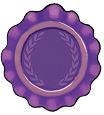
Read Winning Faction Lore
After determining a winner, the winning player reads their Faction's Victory Lore aloud.
Continue Reading


